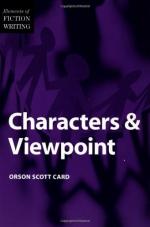
|
| Name: _________________________ | Period: ___________________ |
This test consists of 5 multiple choice questions, 5 short answer questions, and 10 short essay questions.
Multiple Choice Questions
1. What must happen when a narrator does not describe an event in a first person narration?
(a) There should be more than one event taking place at the same time.
(b) There should be a similar event after the one not described.
(c) There should be a similar event before the one not described.
(d) There should be a clear and valid justification.
2. Which type of narrative is most often used when writing from a Presentation perspective?
(a) Third person.
(b) First person.
(c) First person or third person.
(d) First person or second person.
3. What type of relationships can contribute to a character's attitude?
(a) Present.
(b) Past.
(c) Past, present, or future.
(d) Future.
4. In the author's opinion, what must a transformation be?
(a) Justified.
(b) Logical.
(c) Complete.
(d) Justified and logical.
5. What is a Representation perspective?
(a) A narrative that prevents the reader from responding to a story.
(b) A narrative that reminds the reader they are being told a story.
(c) A narrative that allows the reader to forget they are being read a story.
(d) A narrative that influences the reader how to respond to the story.
Short Answer Questions
1. Which one of the following is not given in Chapter 12 as a reason for characters to change themselves?
2. What should the motives reveal when making a character more believable?
3. What are the other words used by the author to describe random transformations in characters?
4. How should exaggeration be used when writing a comedy?
5. What should the writer avoid when defining the voice of a narrator?
Short Essay Questions
1. What happens when a reader interprets a change in a character that was not intended?
2. What are some of the techniques for interjecting humor?
3. What are the most common tenses used in narration and how does the author describe the risks involved with using different ones?
4. What is the value of justification and how does a writer decide the amount to include in a story?
5. What are some of the limitations and advantages of the first person narrative?
6. What can contribute to a powerful sense of attitude for a character?
7. What are the three levels in which a writer can penetrate the mind or experience of a viewpoint character?
8. What are some of the consequences that are beyond a character's control and provoke a transformation?
9. In Chapter 18, how does the author describe the potential of a writer in finding characters?
10. What are the advantages to using an omniscient or limited narration?
|
This section contains 901 words (approx. 4 pages at 300 words per page) |

|




